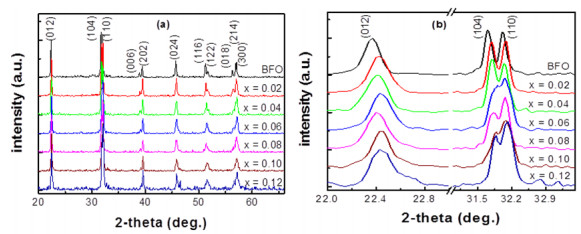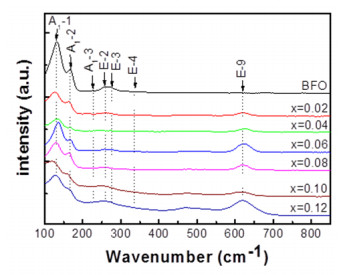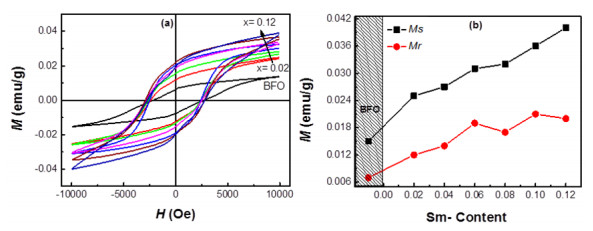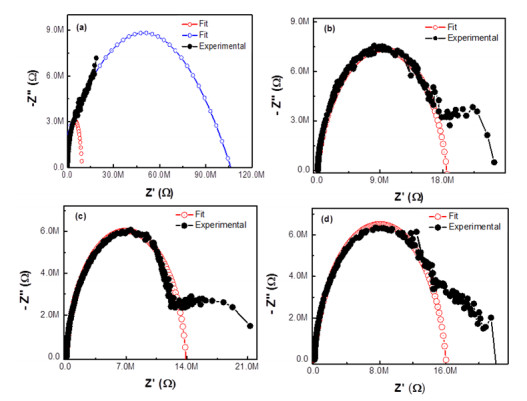1.
Introduction
Multiferroic materials are known from several previous studies to contain coexisting ferromagnetic (antiferromagnetic), ferroelectric orders and to exhibit ferroelasticity and magnetoelectric (ME) effect in the same structure phase [1,2,3,4]. These materials have found broad application in electronic devices, such as information storage, memory sensor, and also in ultrasonic technologies. Due to the competition between the ferromagnetic and the ferroelectric orders, the multiferroic materials are very rarely available in the nature. BiFeO3 (BFO) has a small saturated magnetization and a small electric polarization, that limit the applicability of this materials. This problem can be solved by modification of the magnetic and electrical properties substitution of rare earth ions (such as Sm3+, Nd3+, Gd3+, Ho3+, etc.) into the Bi-sites [5,6,7] or transition metal ions (such as Ni2+, Co2+, Mn2+, etc.) into the Fe-sites [8,9,10]. Recently, some studies showed that both the ferromagnetic and ferroelectric properties are enhanced as rare earth (RE) and transition metal (TM) ions are co-doped into the BFO host materials [11,12,13]. Chakrabarti et al. [14] and Zhang et al. [15] pointed out that the magnetization of (Eu, Co) or (La, Co) co-doped BFO was enhanced by a few times of that the parent BFO compound. Ye et al. [16] also have shown that the (Ho, Mn) co-doped BFO compound exhibit to improve ferromagnetic and ferroelectric properties compared to those of BFO.
In this work, Sm and Mn are chosen for co-doping into the BFO host materials. Because Sm-doped BiFeO3 can improve magnetic and dielectric properties, Mn substitution for the Fe-site is expected to further affect the magnetic and ferroelectric properties to a greater extent resulting in a larger ME effect at room temperature [16,17,18]. Some previous studies also have shown that the Mn concentration of about 2% to 3% molar was the appropriate one for effectively doping into the BFO host materials [12,19,20]. In this work, we use a fixed Mn concentration of 3% molar and a Sm concentration in the range from 2% to 12% molar to study the effect (Sm, Mn) co-doping on the structural and other physical properties of BFO.
2.
Materials and methods
2.1. Materials synthesis
Pure BiFeO3 and (Sm, Mn) co-doped BiFeO3 materials were synthesized by citrate method. The firstly, Bi(NO3)3·5H2O, Fe(NO3)3·9H2O, Sm(NO3)·6H2O, and Mn(NO3)2·4H2O were dissolved in 35 mL citric acid solution. The solution was then mixed by magnetic stirring at the temperature of 60 ℃ for 45 min to obtain so solution. Then, temperature of the sol was increased to 100 ℃ to evaporate the water for 3 h obtaining the wet gel. In the next, the gel was dried at 130 ℃ for 4 h. Finally, dry gel was annealed at temperature 800 ℃ for 7 h in air to obtain the powder materials. The chemicals used were: Bi(NO3)3·5H2O (Sigma-Aldrich, 98%), Fe(NO3)3·9H2O (Sigma-Aldrich, 98%), Sm(NO3)3·6H2O (Sigma-Aldrich, 99.99%), Mn(NO3)2·4H2O (Sigma-Aldrich, 98%), C2H6O2 (Sigma-Aldrich, 98%), and HOC(COOH)(CH2COOH)2 (Sigma-Aldrich, 99%).
For the measurements of the complex impedance and electric polarization hysteresis loops of all samples, powder materials were compressed at a pressure of 20 MPa into pellets of 6.106 nm in diameter and 106 nm in thickness. The pellets were sintered at of 800 ℃ for 5 h. Then, the ceramic pellets were polished to the accurate thickness. Finally, the samples were evenly covered with Pt glue as electrode and sintered at of 500 ℃ for 3 h to obtain the appropriate specimens for the measurements of complex impedance spectra.
2.2. Microstructural characterization
The microstructure, magnetic and ferroelectric properties of all samples were investigated by using X-ray diffraction (D8 Advance, Cu-Kα radiation), Raman scattering (LabRAM HR Evolution, λ = 532 nm), magnetization hysteresis loops (Lake Shore Cryotronics, 704 VSM), and electric polarization hysteresis loops (Radiant, Precision LC 10 V), and complex impedance measurement (LeCroy equiment with frequency range from 10 Hz to 5.3 MHz and using the LabView 8.0 software).
3.
Results and discussion
3.1. X-ray diffraction
The phase formation and crystal structure of BiFeO3 (BFO) and (Sm, Mn) co-doped BiFeO3 materials were investigated by X-ray diffraction (XRD). The XRD patterns of all samples are shown in Figure 1. The refinement of these patterns following the standard cards JPCDS No. 71-2494 revealed that all samples exhibit rhombohedral crystal structure of the original BiFeO3 compound. The main diffraction peaks could be indexed to the (012), (104), (110), (006), (202), (024), (116), (122), (018), and (300) crystalline planes, as indicated in Figure 1a. The XRD patterns of (Sm, Mn) co-doped samples show that Sm3+ and Mn2+ ions are well incorporated into the BFO crystal lattice. Figure 1b shows a comparison of the positions of the (012), (104) and (110) peaks, which may depict the effects of (Sm, Mn) co-doping on the crystal structure of BFO. As it is seen, the corresponding peaks of the (Sm, Mn) co-doped samples shift toward higher 2θ values compared to those of the undoped BFO sample. From data of XRD analysis, the crystal lattice parameter and the average crystallite size (LXRD) have been determined by using the UnitCell software and the Debye Scherrer’s formula, and results are shown in Table 1. As seen in Table 1, the BFO sample has crystal lattice parameters of a = 0.5584 nm, c = 1.3875 nm and the average crystal size LXRD = 60 nm. It is also seen that the crystal lattice parameters and the average crystal size of the (Sm, Mn) co-doped samples decrease when the Sm-concentration increases. This observation can be easily understood considering the large ionic radius of Mn2+ (0.067 nm) compared to that of Fe3+ (0.065 nm). When the Mn2+ ions are substituted into Fe-sites they cause an expansion of the crystal lattice, which in turn increases the length of the Fe/Mn–O bonds. For the (Sm, Mn) co-doped samples, the diffraction peaks shift toward higher 2θ values compare to those of the BFO sample, which could be explained as due to the smaller ionic radius of Sm3+ (0.108 nm) compare to that of Bi3+ (0.117 nm). The presence of the small Sm3+ ions leads to the contraction of the crystal lattice. Furthermore, the Sm3+ ion with the small ionic radius is not large enough to fill the 12-sided cavity created by the BO6 octahedron causing the BO6 octahedron to rotate (B-site is Fe or Mn), which reduces the 12-sided cavity volume. So, at the low concentration of Sm (x ≤ 0.08), the value of a lattice parameter seems to remain unchanged while the value of c slightly decreases to compared with that of BFO sample. For the (Sm, Mn) co-doped samples with higher Sm-concentrations, the rotation BO6 octahedron is significant leading to the significant reduction of both the a and c parameters. So, the simultaneous substitution of Sm3+ and Mn2+, respectively, into the Bi-sites and the Fe-sites leads to the shrank of the crystal lattice, which is related to the decrease of the Bi/Sm–O bonds. This may be the reasons for the decrease of the crystal lattice parameters and the average crystal size, as shown in Table 1. Previous studies also indicated that the lattice parameters change due to the fact that ionic radius of Sm3+ is smaller than that of Bi3+ and the ionic radius of Mn2+ is larger than that of Fe3+ [21].
3.2. Raman scattering spectra
Raman scattering spectra of BFO and Bi1–xSmxFe0.97Mn0.03O3 (x = 0.02, 0.04, 0.06, 0.08, 0.10, and 0.12) materials, as shown in Figure 2. According to the group theory, 13 Raman active modes could be expected for the rhombohedral BFO structure with the R3C space group (Γ = 4A1 + 9E) [22,23]. However, not all modes could be clearly observed at room temperature. In the analysis of the Raman scattering spectra for all samples, the positions of the Raman active modes for all samples are fitted by the Gaussian function. As one can see in Figure 2, Raman scattering spectra of the BFO sample has A1-1,
A1-2, A1-3, E-2, E-3, E-4 modes, whereas Raman scattering spectra of the (Sm, Mn) co-doped samples have A1-1, A1-2, A1-3,
E-2, E-3, E-4 and E-9 modes. When concentration of Sm increases the A1-1, A1-2, A1-3,
E-2, E-3, and E-4 modes shift toward the higher frequencies compared to the situation in the BFO sample. Previous studies have also shown that the A1 modes and the E modes both at low frequencies are characteristic for the Bi–O covalent bonds, while other E modes at high frequencies are characteristic for the Fe-O bonds [24]. The A1-1,
A1-2, A1-3, E-2, E-3, and E-4 modes are found characteristic for the Bi-O covalent bonds [13,25], while the E-9 mode is characteristic for the Fe–O bonds [10,26]. So the observed change positions of the E-9 modes shall confirmed that the Mn2+ ions are substituted into the Fe-sites, and the change of the positions of the A1-1, A1-2,
A1-3, E-2, E-3, and E-4 modes also confirmed Sm3+ ions being substituted into the Bi-sites. These results are consistent with the XRD results, which confirmed that Sm3+ and Mn2+ ions are substituted into the Bi- and the Fe-sites, respectively.
3.3. Magnetic properties
Figure 3a shows the magnetic hysteresis loops recorded for the BFO and Bi1–xSmxFe0.97Mn0.03O3 (x = 0.02, 0.04, 0.06, 0.08, 0.10, and 0.12) compounds at room temperature. As it is seen in Figure 3a, all samples present a weak ferromagnetic behavior. The BFO sample has a saturation magnetization Ms = 0.015 emu/g and remnant magnetization Mr = 0.007 emu/g. For the (Sm, Mn) co-doped samples, the Ms and Mr values increase up to Ms = 0.04 emu/g and Mr = 0.02 emu/g, as are seen in Figure 3b. These results could be understood from the following consideration. Firstly, the substitution of the Mn2+ ions into the Fe-sites creates the exchange interaction between the Mn2+ ions with the neighbouring Fe3+ ions [27,28] leading to the change of the material’s magnetic state from the antiferromagnetic to the ferrimagnetic order; Secondly, there exist double exchange interaction in the Fe3+–O2––Mn2+ chains resulting from the contribution of the 3d electrons in the magnetically active Fe/Mn atoms; Thirdly, the substitution of metal ions with another different valence state (i.e. Mn2+) leads to the structural lattice distortion and/or the breakdown of the balance between the antiparallel magnetizations in the sublattice of the Fe3+ ions. This can cause the canting of the antiferromagnetic ordering spins and thus enhances the total magnetization of materials [28]; Furthermore, the substitution of the Mn2+ ions into the BiFeO3 crystal lattice creates oxygen vacancies and lattice defects, which in turn also contributes to the enhancement of the material’s magnetization [29].
3.4. Ferroelectric properties
Figure 4a shows the room temperature polarization as a function of applied-electric fields of BFO and (Sm, Mn) co-doped samples. It is clear that all the samples show ferroelectric behavior. The ferroelectric properties are clearly improved in (Sm, Mn) co-doped samples compared to that of the BFO sample. The saturation polarization (Ps) and remnant polarization (Pr) values of BFO and (Sm, Mn) co-doped samples, as shown in Figure 4b. For (Sm, Mn) co-doped samples show the Ps and Pr values, indicating the best improvement of ferroelectric properties of BFO with (Sm, Mn) co-doping. This observation can be explained as the substitution of Sm into the Bi-sites, leading to modification of the Bi/Sm–O bonding. On the hand, the substitution of Mn into Fe-sites created oxygen vacancies and changes the FeO6 octahedron, leading to enhancement of Ps and Pr.
3.5. Complex impedance spectra
Figure 5 shows complex impedance spectra of the BiFeO3 and Bi1–xSmxFe0.97Mn0.03O3 (x = 0.02, 0.06, and 0.08) materials. The complex impedance spectra of materials are known to consist of the various contributions from intra- and inter-grains, grain boundaries, and the electrode interfaces. The complex impedance spectra in term of the Cole-Cole plot are presented in successive semicircles indicating the imaginary part vs. the real part in the complex plane. A high frequency semicircles originate from intragrain contributions, a semicircle in the intermediate frequency provides information on the contributions from the grain boundaries, whereas the low frequency semicircle associates to the ion and electron transfer at the contact interface between the sample and the measuring electrode [12,30,31]. Impedance spectra are determined by the frequency range of the measurements, but all these contributions may not be ruled out. Some previous studies also showed the distinction between the intra and the inter-grain contributions which are related to the defects in ferroelectric materials [32,33]. The complex impedance spectra thus can provide reliable information on the dielectric properties of materials. In our work, for all samples, the simulated curves agree quite well with the experimental ones. As it is seen in Figure 5, the impedance spectra of the BFO and (Sm, Mn) co-doping samples consist of a semicircle at the high frequency region, toward zero in the complex plane presenting the intragrain contribution and a semicircle at the intermediate frequency, untoward zero in the complex plane presenting the grain boundaries. However, due to limited measurement frequency range, the contribution of the electrode interface to the impedance could not be fairly detected in all the investigate samples. These presented results provide, thus, just some preliminary information pointing out significant modification of the dielectric properties of the (Sm, Mn) co-doped BiFeO3 materials. Which is consistent with results of the hysteresis loop measurement showed the ferroelectric properties of (Sm, Mn) co-doping samples was improved to compared with that of BFO sample.
4.
Conclusion
In summary, BiFeO3 and Bi1–xSmxFe0.97Mn0.03O3 (x = 0.02, 0.04, 0.06, 0.08, 0.10, and 0.12) materials have been successfully fabricated by citrate method. All samples crystallize in rhombohedral structure of BiFeO3 materials. Crystal lattice parameters and average crystallite size of (Sm, Mn) co-doping samples decreased gradually compared to those of BiFeO3 sample. X-ray diffraction patterns and Raman scattering spectra confirmed the successful substitution of Sm3+ and Mn2+ ions into Bi- and Fe-sites, respectively, which affected obviously to magnetic and ferroelectric properties of BiFeO3 host materials. Magnetic and ferroelectric properties of (Sm, Mn) co-doping samples enhanced to compared with those of BiFeO3 materials.
Acknowledgements
This work has been supported by the Ministry of Education and Training of Vietnam (Code B2018-MDA-02-CtrVL).
Conflict of interests
The authors declare no conflicts of interests.










 DownLoad:
DownLoad:







